Frogs and toads are found on every continent, except Antarctica. Over the past 2 million years, these amphibians have adapted to a wide variety of niches all over the world. There are over 2700 species of frogs and toads worldwide, with new species being discovered regularly. In Canada, there are 25 species, and in Ontario there are 13. Ontario frogs and toads live in a variety of habitats including terrestrial (land), aquatic (water) and arboreal (in trees) and they can even be found at the most northern latitude of the province.
The frogs and toads of Ontario are divided into 3 types:
-
True Toads
- American Toad
- Fowler’s Toad (at-risk)
-
Treefrogs
- Boreal Chorus Frog
- Gray Treefrog
- Spring Peeper
- Western Chorus Frog
-
True Frogs
- American Bullfrog
- Green Frog
- Mink Frog
- Northern Leopard Frog
- Northern Cricket Frog
- Pickerel Frog
- Wood Frog
[/one_third_last]
Ontario frogs and toads lay their eggs in water which later hatch into tadpoles in the spring. Some northern species (green, mink and bull frogs) overwinter in tadpole form due to shorter seasons. Tadpoles are vegetarians, but once in their adult form, they will eat insects and sometimes birds, mammals, snakes or other frogs. I’ve even seen one try to eat a caterpillar, but it ended up spitting it out!
To survive the Ontario winters, frogs and toads have developed their own survival techniques. American Toads burrow into the ground and survive under the frost line. Gray Tree Frogs, Spring Peepers, and Wood Frogs all hibernate under piles of leaves, logs or rocks and they increase the amount of glucose in their organs to survive freezing (like antifreeze). Northern Leopard Frogs, Bullfrogs, Green Frogs and Mink Frogs all hibernate in water that is deep enough not to freeze solid.
In Southern Ontario, you can start hearing the calls of male frogs and toads in late March or April / May in Northern Ontario. Spring Peepers, Wood Frogs and Chorus Frogs are usually the first you’ll hear. Bullfrogs may not start calling until late June or July. Each frog species’ call is very distinct and is very useful in identification, especially since you can often hear them but not see them. Check out Nature Watch’s site to see pictures, descriptions and sounds of each of Ontario’s 13 species. You can also help with research and conservation by becoming a Frog Watcher. Dusk is usually the best time to listen for frogs but some species (Green Frogs and Spring Peepers) will call during the day, especially after the rain.
Comparing Frogs & Toads
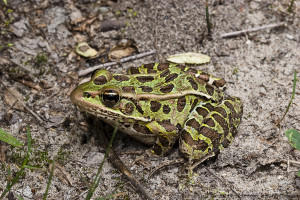
FROGS
- Hind legs are long and powerful for jumping
- Skin is moist and smooth
- Spend most of their time in the water
- Eyes bulge out
- Have a lot of predators to worry about
[one_half_last]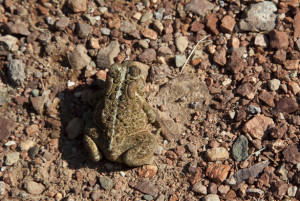
TOADS
- Hind legs are shorter for walking and hopping
- Skin is dry and bumpy
- Spend most of their time on land
- Eyes do not bulge
- Have fewer predators
[/one_half_last]
Frogs are an indicator species and can tell us a lot about the environmental health of the ecosystem they are living in. Frogs and toads have a semi-permeable skin and live ‘between water and land’ and are therefore easily affected by pollution and other environmental changes.
Factors Affecting & Threatening Amphibians:
Habitat fragmentation
Introduction of Exotic Species
Collecting
Disease
[one_third_last]Acid Rain
Agricultural Chemicals
Hormone-mimicking Chemicals[/one_third_last]
 Frog & Toad Facts:
Frog & Toad Facts:
[two_third_last]
[/two_third_last]
Sources:
Canadian Amphibian and Reptile Conservation Network. [Accessed 06 May 2015].
“Canadian Herpetological Society.” CARCNET. N.p., n.d. Web. 06 May 2015.
Cook, Francis R. (1984). Introduction to Canadian Amphibians and Reptiles. National Museums of Canada: Ottawa, ON.
Frogs and Toads of Ontario. Adopt-A-Pond, Toronto Zoo. [Accessed 06 May 2015].
FrogWatch Ontario. [Accessed 06 May 2015].
“Frogs and Toads of Ontario.” NCC:. N.p., n.d. Web. 06 May 2015.
“Frog vs Toad.” – Difference and Comparison. N.p., n.d. Web. 06 May 2015.


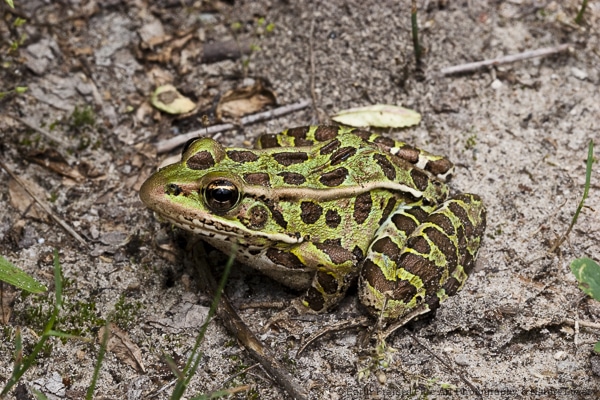
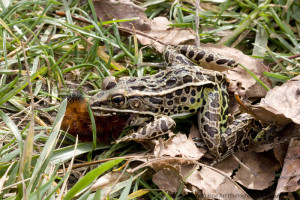
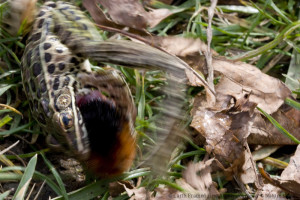
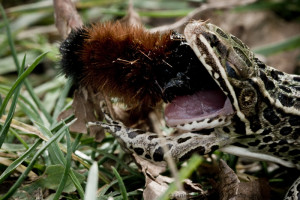
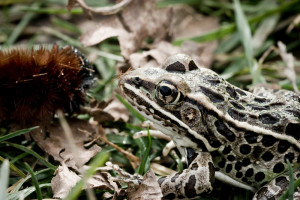
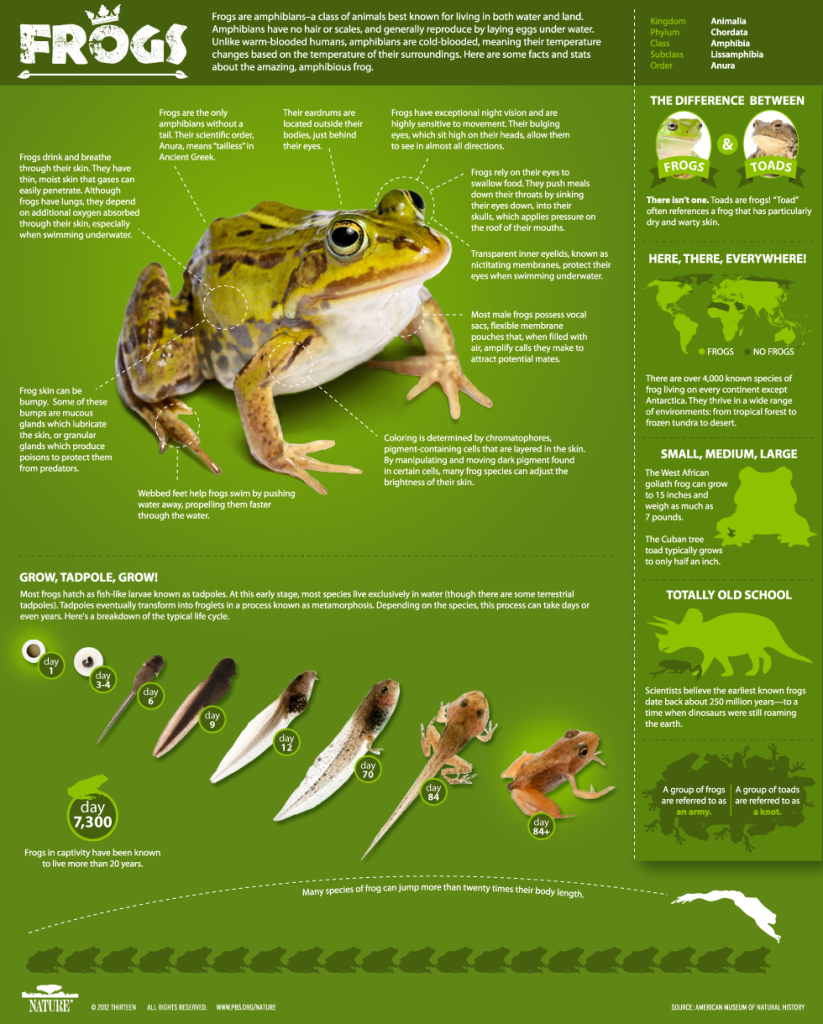
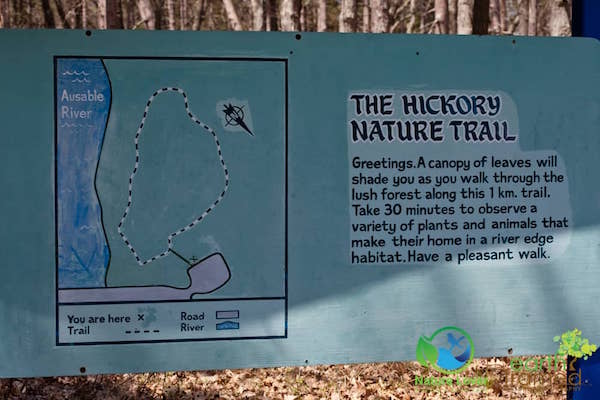
Comments(4)
Deborah Kazakoff says:
July 20, 2021 at 8:57 amI was wondering how long a gestation period was for a common frog (land) in SW Ontario.
I came upon your information and am pleased that you have researched for some time.
Hello.
Tricia McLellan-Dath says:
August 25, 2021 at 11:03 amDepending on the type of frog, the eggs can hatch anytime between 3 and 26 days after being laid.
Sandy says:
July 3, 2020 at 9:41 amThis is a very clear and concise fact sheet for learning about the frogs in my particular ecosystem. Over the years I have built a water garden complete with falls, streams lots of rocks etc. I have kept it as natural as possible and learned that is important not to mess with nature. No matter how much it looks like it needs cleaning, I put up a huge Do not Disturb sign to encourage all wildlife. I am truly surprised if you keep your eyes wide open and are patient you can discover just how much lives in this micro ecosystem. What a wonderful reward. I take this responsibility very seriously. I created it and wildlife came and has stayed. My biggest surprise when I found gray tree frog sitting on my painting palette in of all places my workshop.
Tricia McLellan-Dath says:
August 25, 2020 at 10:50 amGlad you enjoyed it!